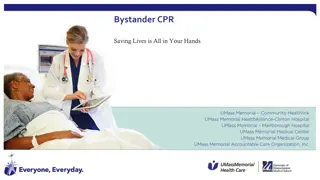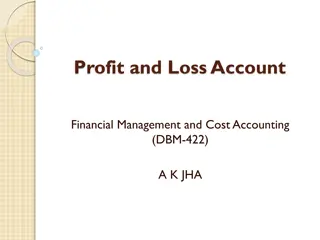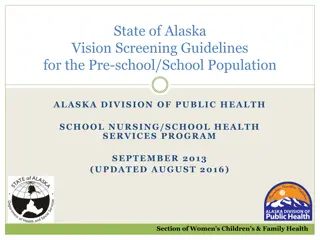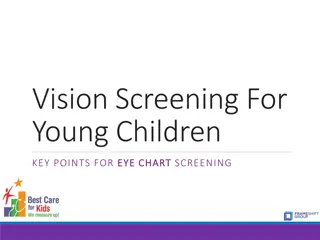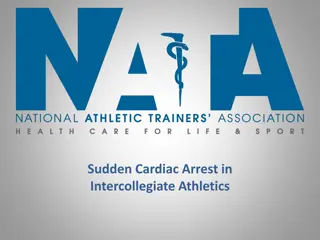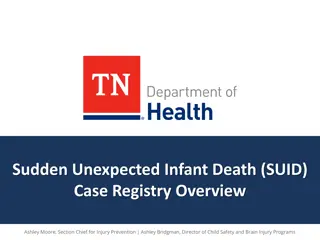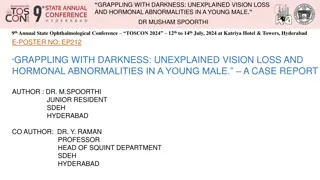Sudden vision loss
A 62-year-old gentleman presents with sudden right-sided visual loss, prompting a differential diagnosis including retinal artery occlusion, optic neuropathy, vitreous hemorrhage, and more. Assessment involves visual acuity, pupil examination, color vision, palpation for tenderness, and ECG to exclude AF.
Download Presentation

Please find below an Image/Link to download the presentation.
The content on the website is provided AS IS for your information and personal use only. It may not be sold, licensed, or shared on other websites without obtaining consent from the author.If you encounter any issues during the download, it is possible that the publisher has removed the file from their server.
You are allowed to download the files provided on this website for personal or commercial use, subject to the condition that they are used lawfully. All files are the property of their respective owners.
The content on the website is provided AS IS for your information and personal use only. It may not be sold, licensed, or shared on other websites without obtaining consent from the author.
E N D
Presentation Transcript
Sudden vision loss Sudden vision loss Guillaume Mignot, ST3
Case 62 year old gentleman Presents to your GP practice with a 2-day history of right sided visual loss
History taking what you want to know Onset sudden VS sub-acute VS slowly developing Any variability? Unilateral VS bilateral Degree of visual loss and what they mean exactly by visual loss is it blurriness? A scotoma? Peripheral VS central? Any eye pain? this is essential as the differential of painful acute visual loss is very different and includes acute angle closure glaucoma not to be missed! Any head aches ? very important, we will come back to this The usual: past medical/ophthalmic history, medications, social history
Case Vision loss was sudden, stable and significant (note if the contralateral has good vision, patients may become aware of sight loss in the contralateral eye when for a reason or another, the good eye is occluded i.e. the actual sight loss may have happened a long time prior to the patient noticing it) No eye pain No headache, otherwise fit and well Takes a statin for cholesterol and knows his BP is borderline Smokes 10 cigarettes/day
What is your differential diagnosis for a patient with profound sudden painless visual loss? 1) Central retinal/branch retinal artery occlusion (CRAO/BRAO) VS central retinal/branch retinal vein occlusion CRVO/BRVO (identical symptoms, impossible to differentiate based on history alone) 2) Non-arteritic anterior ischaemic optic neuropathy (NAAION) a barbaric name 3) Vitreous haemorrhage 4) Retinal detachment 5) Arteritic anterior ischaemic optic neuropathy (AAION) aka NAAION s evil twin i.e. GCA
How would you assess the patient? Visual acuity Check pupils and assess for a relative afferent pupillary defect (aka RAPD aka Marcus Gunn pupil) Colour vision (if you have the kit, otherwise don t worry about it) Palpate for scalp tenderness and check that the temporal arteries are soft and pulsatile bilaterally Auscultate the carotids + heart for bruits Perform an ECG to exclude AF You can perform fundoscopy, but don t worry, this is a bonus and in no way essential, the above, however, are essential
Checking visual acuity This is absolutely essential and is by far the most important investigation when dealing with an ophthalmic issue With phone applications, you don t even need to have a chart any more
How to check VA Test each eye separately i.e. occlude one eye Each Snellen chart is designed to be looked at from a specific distance make sure your patient is sitting at the right distance. With phone apps, you can select the distance (I usually select 3 meters as this is the most convenient) the app will do the rest and alter the size of the letters accordingly Note: even if you check VA with the patient sitting at 3 meters, the results will always be expressed as a fraction of 6 (as if the patient was at 6 meters) Americans use feet, so their 6 meters is 20 feet i.e. 20/20
6/6, 6/36, 6/9-2 etc what does this mean??? The Snellen chart is based on the assumption that an average person should be able to read all letters on the 6 meter line, when reading at 6 meters i.e. 6/6 means your patient can read at 6 meters what your average person can also read at 6 meters 6/12 means that your patient needs to be at 6 meters to read what an average person could read from 12 meters 6/12 with both eyes open (this may be an only eye) and no significant field defect is the minimum driving standard in the UK
6/6, 6/36, 6/9-2 etc what does this mean??? When vision becomes poorer than 6/60, we stop using the chart and VA can be assessed using: - Counting fingers (CF) - Hand movements (HM) - Perception of light (PL) - And no perception of light i.e. total blindness (NPL) - What about 6/9+2? This means your patient could read all letters on the 6/9 line PLUS 2 letters from the 6/6 line, 6/6-2 means the patient could read all but 2 letters on the 6/6 line
Pin hole Since you won t have a pin hole, you can ignore this slide A pinhole selects only the rays of light that come perpendicular to the eye i.e. will reach the retina undeviated by the cornea or the lens If you have a small myopic prescription for example, you should be able to read 6/6 with a pinhole If VA increases with pinhole, it means that there is a problem anterior to the retina i.e. a refractive issue
Relative afferent pupillary defect (RAPD) the swinging light test Another barbaric term but one to know since it can be examined in you OSCE All reflexes have an afferent limb(sensory information carried to the CNS) and an efferent limb (motor impulse sent to a muscle) In the case of the pupillary reflex, afferent information (light perception) is carried out by the optic nerve (CNII) and a stimulus is sent to the spincter pupillae to constrict via the oculomotor (CNIII) nerve You are therefore looking for pathology of the optic nerve/retina
Relative afferent pupillary defect (RAPD) the swinging light test The pupillary reflex is composed of both: - a direct response: you shine the light in one eye and that pupil constricts (i.e. light in right eye, right pupil constricts) - a consensual response: you shine the light in one eye and the contralateral pupil constricts) In a complete RAPD, the affected eye may show no pupillary response to bright light However, this will constrict normally to light in the contra-lateral eye in virtue of the consensual response i.e. the contralateral CNII and ipsilateral CNIII are intact
Relative afferent pupillary defect (RAPD) the swinging light test Be careful, a patient with a RAPD may still have normal direct responses However, as the light goes from the normal to the affected eye, the intensity of perceived stimulus by the brain will decrease As this happens, both pupils will slowly dilate As you swing the light back on to the healthy eye, you will notice both pupils constricting back Please watch this excellent video to understand this essential test: https://www.youtube.com/watch?v=HSYo7LhfV3A
Why is an RAPD useful? If present, it localises the pathology to the optic nerve or retina A very dense cataract, corneal ulcer or vitreous haemorrhage should NOT cause an RAPD Differential of a positive RAPD - CRAO/CRVO - optic nerve trauma/ischaemia/demyelination (essential examination in suspected optic neuritis) - advanced asymmetric glaucoma - retinal detachement - severe retinitis
Results from the consultation + examination Patient reports vision loss was sudden, unilateral, painless Minimal improvement since, visual acuity: counting fingers Obvious right sided RAPD Audible right sided carotid bruit
What is your top differential? CRAO You have a patient with vascular risk factors, profound loss of vision and a positive RAPD localising the pathology to the optic nerve/retina The ipsilateral carotid bruit may suggest atherosclerotic plaque leading to an embolus which then went to occlude the CRA The picture shows the classic cherry red spot this is the fovea, seen red because the surrounding retina is ischaemic but the red from the intact choroidal circulation (not from the CRA) can be seen through the thin fovea) this view is only possible with a slit lamp, so it is almost futile to try to see this with a direct ophthalmoscope
Differentials CRVO very difficult to differentiate in terms of history or VA/RAPD it will be obvious on fundoscopy with the stormy sky fundus i.e. haemorrhages +++ and vascular tortuosity due to increased venous pressure GCA causing a vasculitic CRAO or optic nerve infarction Optic nerve ischaemia (NAAION) again, very difficult to differentiate without fundoscopy and would affect the same vasculopathic demographic, the nerve, however, is likely to be swollen Demyelination i.e. optic neuritis: this is classically associated with a dull pain on eye movement and occurs typically in younger females
Differentials Retinal detachment: this would usually be heralded by flashes and floaters. Retinal detachements usually start in the periphery and progress centrally i.e. patients usually report a shadow before the detachment takes off their macula and central vision drops. However, patients often don t see the shadow and present with sudden painless vision loss Angle closure glaucoma extremely unlikely without pain
Could this be a stroke? (of the brain) NO! The symptoms are MONOCULAR Remember, a lesion posterior to the chiasm necessarily (well almost necessarily but don t bother about that ) causes bilateral field defects The right field of the right eye decussates to the left lobe and vice versa
What should you do? EXCLUDE GCA this is the first thing ophthalmology will ask you to do and worth emphasizing take a good history (very, very rare in those under 60), examine the temporal arteries, take bloods for CRP/ESR/FBC. GCA is a CLINICAL diagnosis if you think this is likely, start treatment without any delay (high dose steroids) and take bloods as inflammatory markers will rapidly fall after initiating steroids GCA is a systemic condition which can affect the eye the fact that the patient has no eye involvement yet in no way means he does not have GCA i.e. ophthalmology canot exclude GCA , we can only exclude ophthalmic involvement in GCA
A bit more about GCA GCA can affect the eye in many ways The most common ocular manifestations are optic nerve infarction leading to sudden, profound visual loss with little potential for improvement even with steroids (arteritic, ischaemic optic neuropathy i.e. A-AION), or a CRAO (equally poor prognosis) Patients with eye involvement should get high dose methylprednisolone Why? Mainly to protect the contralateral from having the same faith Once your patient is safe, you can refer them to ophthalmology/rheumatology (ophthalmology does not need to see GCA cases without eye involvement) The gold standard is a temporal artery biopsy, steroids will reverse the changes but this won t happen overnight you have a good few weeks to perform it after starting steroids so don t wait
What should you do? (continued) Once you have excluded GCA, refer the patient to ophthalmology If this is a CRAO, you will need to treat it as a stroke of the eye i.e. start aspirin 300 mg and a statin and refer to the neurovascular clinic for ECG, carotid Doppler and cardiac ultrasound No driving for 1 month If an emboligenic carotid is found, the patient may benefit from an endarterectomy
Take home messages In sudden painless vision loss, the most important is to make sure this is not GCA, and refer to ophthalmology Basic examination skills are all you need, fundoscopy is optional Focus on visual acuity, RAPD and a good cardiovascular examination Monocular visual issues almost never originate from the brain




